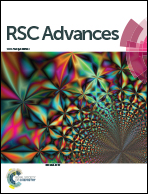Highly efficient colorimetric detection of ATP utilizing a split aptamer target binding strategy and superior catalytic activity of graphene oxide–platinum/gold nanoparticles†
Abstract
In this study, a highly efficient colorimetric assay for adenosine triphosphate (ATP) was constructed based on a split aptamer target binding strategy and grapheme oxide–platinum/gold nanoparticle platform to increase catalytic properties. Platinum/gold nanoparticles were easily prepared by reducing the mixture solution of K2PtCl6 and HAuCl4 using sodium citrate in a one-pot synthesis. Next, graphene oxide/platinum/gold nanoparticle hybrids (GO/PDDA/PtAuNPs) were fabricated using a self-assembly procedure. Ultrasensitive and enzyme-free detection of ATP in fetal bovine serum was achieved using split aptamer-modified magnetic beads as a separating unit and split aptamer-modified GO/PDDA/PtAuNPs as a catalyst-detecting platform. The specific binding of ATP and its aptamer linked the split aptamer-modified GO/PDDA/PtAuNPs and magnetic beads together. Using magnetic separation, achromatous tetramethylbenzidine was catalyzed into a colored product by separated nanocomposites, which enabled rapid detection of ATP. The color change caused by the low concentration ATP (50 nM) was clearly distinguished by direct observation. The detection limit of the colorimetric assay for ATP was 0.2 nM, which is close to the lowest detection limit for colorimetric detection of ATP. This assay showed excellent selectivity against guanosine triphosphate, uridine triphosphate, and cytosine triphosphate and can be applied in real samples.


 Please wait while we load your content...
Please wait while we load your content...